The Intel Core i9-7980XE and Core i9-7960X CPU Review Part 1: Workstation
by Ian Cutress on September 25, 2017 3:01 AM ESTBenchmarking Performance: CPU Rendering Tests
Rendering tests are a long-time favorite of reviewers and benchmarkers, as the code used by rendering packages is usually highly optimized to squeeze every little bit of performance out. Sometimes rendering programs end up being heavily memory dependent as well - when you have that many threads flying about with a ton of data, having low latency memory can be key to everything. Here we take a few of the usual rendering packages under Windows 10, as well as a few new interesting benchmarks.
All of our benchmark results can also be found in our benchmark engine, Bench.
Corona 1.3: link
Corona is a standalone package designed to assist software like 3ds Max and Maya with photorealism via ray tracing. It's simple - shoot rays, get pixels. OK, it's more complicated than that, but the benchmark renders a fixed scene six times and offers results in terms of time and rays per second. The official benchmark tables list user submitted results in terms of time, however I feel rays per second is a better metric (in general, scores where higher is better seem to be easier to explain anyway). Corona likes to pile on the threads, so the results end up being very staggered based on thread count.
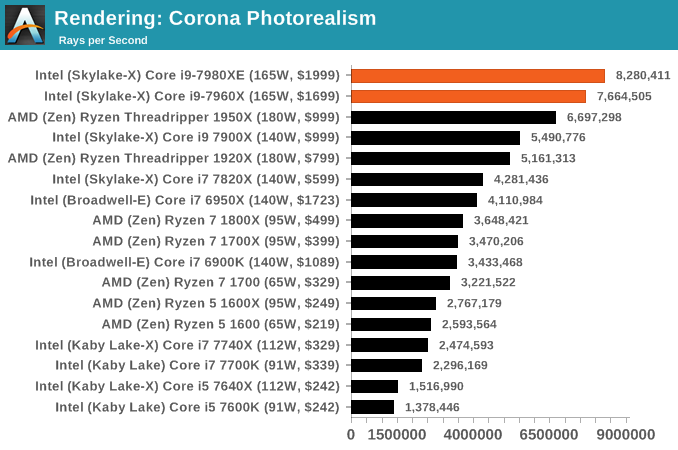
Blender 2.78: link
For a render that has been around for what seems like ages, Blender is still a highly popular tool. We managed to wrap up a standard workload into the February 5 nightly build of Blender and measure the time it takes to render the first frame of the scene. Being one of the bigger open source tools out there, it means both AMD and Intel work actively to help improve the codebase, for better or for worse on their own/each other's microarchitecture.

LuxMark v3.1: Link
As a synthetic, LuxMark might come across as somewhat arbitrary as a renderer, given that it's mainly used to test GPUs, but it does offer both an OpenCL and a standard C++ mode. In this instance, aside from seeing the comparison in each coding mode for cores and IPC, we also get to see the difference in performance moving from a C++ based code-stack to an OpenCL one with a CPU as the main host.
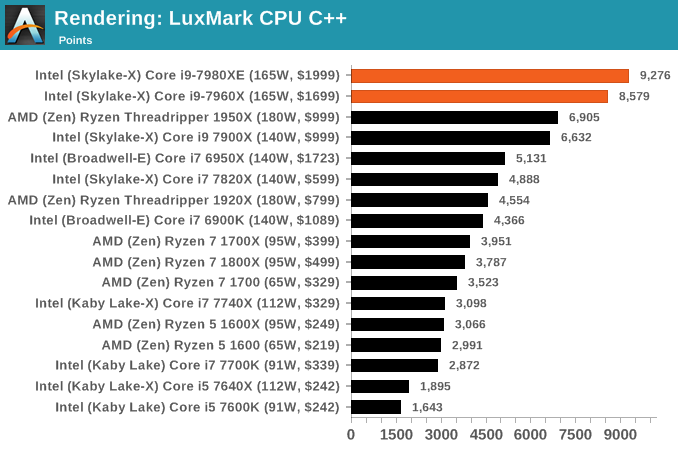
POV-Ray 3.7.1b4: link
Another regular benchmark in most suites, POV-Ray is another ray-tracer but has been around for many years. It just so happens that during the run up to AMD's Ryzen launch, the code base started to get active again with developers making changes to the code and pushing out updates. Our version and benchmarking started just before that was happening, but given time we will see where the POV-Ray code ends up and adjust in due course.
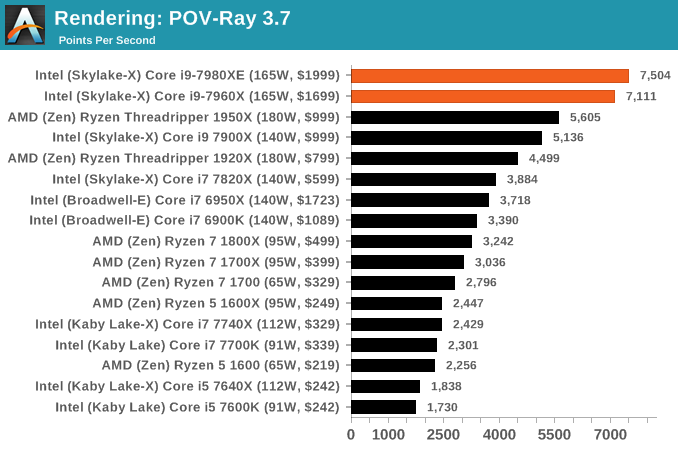
Cinebench R15: link
The latest version of CineBench has also become one of those 'used everywhere' benchmarks, particularly as an indicator of single thread performance. High IPC and high frequency gives performance in ST, whereas having good scaling and many cores is where the MT test wins out.
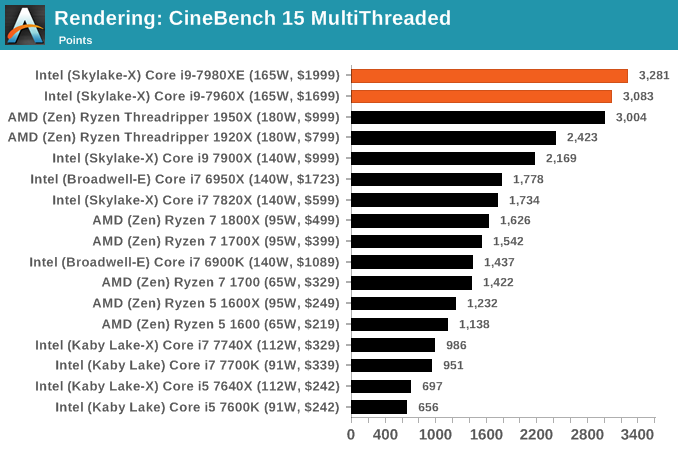
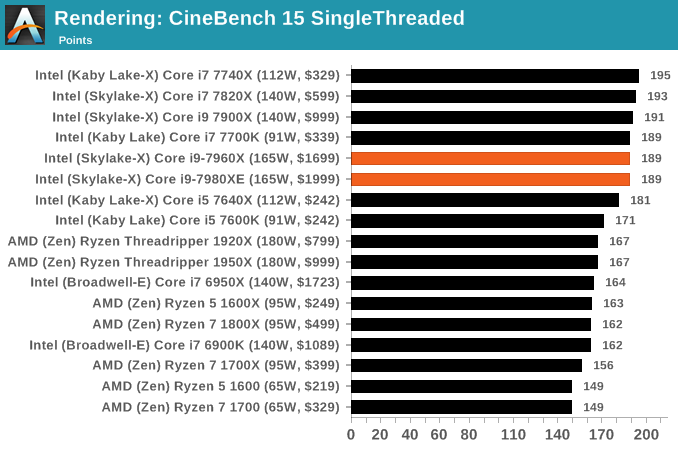










152 Comments
View All Comments
extide - Monday, September 25, 2017 - link
No, TDP should include Turbo as that is part of the base/stock operation mode of the CPU.IGTrading - Monday, September 25, 2017 - link
TDP = Total Design Power by definition.This is used to design the motherboard and the cooling system to give designers a clear limit over which the system doesn't go unless it is purposely overcloked.
Wikipedia : "The thermal design power (TDP), sometimes called thermal design point, is the maximum amount of heat generated by a computer chip or component (often the CPU or GPU) that the cooling system in a computer is designed to dissipate under any workload."
Intel : "TDP (Thermal Design Power) Intel defines TDP as follows: The upper point of the thermal profile consists of the Thermal Design
Power (TDP) and the associated Tcase value. Thermal Design Power (TDP) should be used for
processor thermal solution design targets. TDP is not the maximum power that the processor can
dissipate. TDP is measured at maximum TCASE.1"
Intel : "Due to normal manufacturing variations, the exact thermal characteristics of each individual processor are unique. Within the specified parameters of the part, some processors may operate at a slightly higher or lower voltage, some may dissipate slightly higher or lower power and some may draw slightly higher or lower current. As such, no two parts have identical power and thermal characteristics.
However the TDP specifications represent a “will not exceed” value. "
This is what we've understood by TDP in the past 21 years while in IT hardware industry.
If you have a different definition, then perhaps we're talking about different things.
whatevs - Monday, September 25, 2017 - link
Specification for 7980xe says "Thermal Design Power (TDP) represents the average power, in watts, the processor dissipates when operating at Base Frequency with all cores active under an Intel-defined, high-complexity workload. Refer to Datasheet for thermal solution requirements."There's a different specification for electrical design. This is not your ancient Xeon TDP.
IGTrading - Monday, September 25, 2017 - link
You mean the definition of TDP should change every year to suit Intel's marketing ?! :)"Ancient" Xeon TDP ?! :)
I've quoted Intel's own definition.
If the company just came up with a NEW and DIFFERENT definition just for the Core i9 series, then that's just plain deceiving marketing, changing with the wind (read : new generation of products) .
Plus, why the heck are they calling it TDP ?!
If they now claim that TDP "represents the average power, in watts, the processor dissipates when operating at Base Frequency with all cores active " then they basically use AMD's ACP from 2011.
What a load of nonsense from Intel ...
https://www.intel.com/content/dam/doc/white-paper/...
whatevs - Monday, September 25, 2017 - link
You have quoted 6 year old Xeon definition, different products have different operating conditions, deal with it.Spunjji - Monday, September 25, 2017 - link
Your name suggests that you're kind of a dick and your comments confirm it. Your point is weak and doesn't at all do the work you think it does.whatevs - Monday, September 25, 2017 - link
You may be unhappy with what Intel promised you, but to claim that you could burn a system with increased power usage from turbo clocks is ridiculous, thermal throttling is not fire, and it's ridiculous to argue on a cpu that can run overclocked at >400w power consumption.Notmyusualid - Monday, September 25, 2017 - link
+1wolfemane - Tuesday, September 26, 2017 - link
You can't talk rationale with a loyalist sympathizer. TDP is a set definition in the industry and one Intel seems to be misleading about with their Extreme HEDT CPU. That seems to be a fact clearly made among almost all reviews of the 7980xe.I think I read a few articles yesterday talking about how the 7980xe was having major issues and wasn't boosting correctly but showing high power draw. But yesterday was a long time ago and I cant remember where I read that.
someonesomewherelse - Saturday, October 14, 2017 - link
So why not call it 'Average Design Power - ADP'?